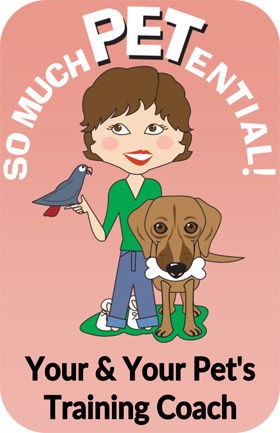Animal Training Using Shaping
NOTE: I have a new pet behavior blog located at http://www.SoMuchPETential.com/blog. Thanks!
Have you ever ‘shaped’ behavior? Sure you have. We all have. If you’ve ever taught a child to talk, write or tie a shoe, you shaped that behavior. If you’ve ever learned to sing or play an instrument, you didn’t begin by playing Bach. If you’ve played baseball, you had to learn how to hit a home run. Your skill set was shaped.
Shaping is behavior science strategy for teaching behaviors by breaking that final ‘target’ behavior down into smaller increments known as successive approximations and reinforcing the animal at each incremental step until the final target behavior is learned.
I love using shaping to teach my pets new behaviors because it is so much fun for both of us – fun for me to challenge myself in being the best teacher I can be and fun for them in trying to figure out the ‘game’ or what it is they need to do to earn the reinforcement from me.
What are other benefits of using shaping?
You can teach your pet a behavior that he otherwise may find very confusing such as when I taught Sam to take a bow or scratch his nose. (the things we get our pets to do)
You can fine-tune a behavior your pet is already doing such as teaching Sam to stay sitting for longer periods of time.
You are encouraging your dog to offer new behaviors, try new things and think out of the box to solve problems.
So, how does it work? Here are some basic steps:
Identify the final behavior you want to teach.
Identify your reinforcers for each approximation. Know which reinforcers are of the highest value. As you progress in difficulty and distractions, you may need to increase the value of your reinforcers that you are offering.
Make a plan that lists all of the closest approximations to the final behavior. The first approximation may or may not be even remotely related to the final behavior.
(Optimally begin in an environment with minimal distractions.) Teach each approximation with positive reinforcement and once performed without hesitation, move on to the next approximation and repeat the process until the final behavior is achieved.
Notes:
It’s good to use a marker or bridge when the approximation is offered, followed by the reward because you more than likely would not be able to give the reinforcer to your pet quick enough to reinforce that specific behavior without a bridge. The marker can be a clicker or it can be a word such as ‘good.’ You will need to first teach your pet association between the marker – conditioned reinforcer – and the treat before using the marker in training of other behaviors.
When teaching new behaviors, reinforcers need to be given immediately after the behavior (approximation) and every time.
Size of approximations matters. If your steps in your plan are too small, your learner may satiate on the reinforcer too quickly and may not be interested in the training. If your steps are too big, it may become too difficult to understand and your learner may lose interest. There is no magic formula here. This is where the fun comes in – for you to figure out how big or small to make your steps and adjust along the way by the feedback your animal is giving you; and for your animal in trying to figure out what you want him to do to get his reinforcement.
If your animal is not learning what you want him to learn, instead of shrugging it off to his being dumb or stubborn, take that as feedback from your student that you need to change your lesson plan.
Shifting to the next approximation. There are several ways – one is to observe the tiny variation in which your pet does an approximation and reinforce the one that is closest to the final behavior. Another way is to withhold the reinforcement for the current approximation and wait until your pet tries to figure out what he needs to do next to get that piece of cheese or whatever your reinforcement is. CAUTION that the second way can set the occasion for some frustration so try to be a better observer and go with the first way!
Below is a video of Canadian assistance dog trainer Donna Hill teaching her dog to move a light switch.















